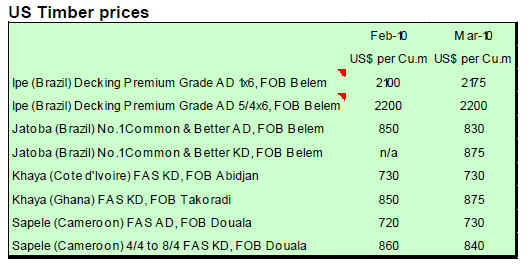|
Report
from
North America
Growth in US manufacturing
In March 2010, the US manufacturing sector reported its
strongest growth since 2004 according to a monthly
survey by the Institute for Supply Management. Economic
activity in the manufacturing sector expanded for the
eighth consecutive month.
Inventories grew in March for the first time in almost four
years, signaling manufacturers¡¯ expectations of increased
orders and sales. Furniture and wood product
manufacturing are among the industries that reported
growth in March.
Furniture order levels rise
Residential furniture orders continue to improve, while
they are not back to 2007 levels, they are moving in a
positive direction. New orders were up by 12% in
December 2009 compared to the previous year, according
to the most recent survey of residential furniture
manufacturers and distributors by the accounting and
consulting firm Smith Leonard in High Point, North
Carolina. Sixty-two percent of the survey participants
reported higher order rates for the month.
Changes to LEED
The US Green Building Council (USGBC) has released
the third draft of LEED¡¯s proposed new certified wood
credit system. The green building rating and certification
programme LEED (Leadership in Energy and
Environmental Design) has grown tremendously in recent
years.
For about two years, the LEED Certified Wood Credit has
been undergoing a process of revision. At the centre of this
process is the USGBC forest certification benchmark that,
if the revision is approved, will be used to judge which
forest certification systems are worthy of recognition
under the LEED Certified Wood Credit.
Wood certification systems would be evaluated for
eligibility to earn points towards LEED certification
against a measurable benchmark that includes criteria on
governance, technical/standards substance, accreditation
and auditing, and chain of custody and labelling.
The current draft includes multiple levels of compliance,
and assigns half-credit, full-credit, or double-credit to
certified wood based on the degree of compliance with the
benchmark.
The likely outcome of this new approach, according to
BuildingGreen.com, is that the Forest Stewardship
Council (FSC) would comply at the full-credit level, while the Sustainable Forestry Initiative (SFI), the Canadian Standards Association (CSA) and other industry-supported certification systems would comply at the half-credit level. FSC-certified wood will contribute to LEED points just as it has in the past, while wood certified by other programs will, for the first time, receive credit in LEED.
Draft criticised
Both industry and environmental groups oppose the new
draft. Industry groups and SFI have criticised the new
draft as FSC-certified wood would keep its preferred
status in LEED. They also argue that by promoting FSCcertified wood, LEED is supporting imported wood
products at the expense of the North American industry,
where the SFI and CSA certifications predominate.
On the other hand FSC has criticized the weakening of
governance rules in the new draft and says that the
mechanism by which the USGBC would measure
conformance to its benchmark is too weak and unclear.
The Cascadia Region Green Building Council, a chapter of
the USGBC, argues that by providing an entry point for
industry-supported programmes the changes in the new
draft ¡°lower the bar¡± for forest certification in LEED, in contrast to other aspects of the building standard that are becoming more stringent.
Industry remains committed to LEDD
Certified wood use accounts for just one point in LEED,
while at least 40 points are required for a building to
achieve the lowest level of LEED certification. Given the
interest and growth in green building, however, the forest industry and forest certification groups have a strong interest in the LEED Certified Wood Credit.
Depending on the comments submitted on this latest draft,
the USGBC may either write a fourth draft or the current
draft will be voted on by the USGBC members.
Tropical lumber prices
Prices for several tropical species firmed during March
because of low inventories in the US and diminished raw
material levels for some suppliers. The Hardwood Review
reports show sales of tropical hardwoods to flooring,
furniture and millwork manufacturers. Generally, demand
for tropical hardwood lumber is still weak and inventories remain low.

|